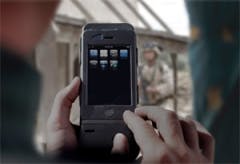MARLBOROUGH, MASS., Nov. 9, 2011. Raytheon Company's (NYSE: RTN) One Force communications solution successfully linked soldiers' smart phones and tablets during the recent U.S. Army Expeditionary Warrior Experiment (AEWE) at Fort Benning, Ga. Data, voice and video over the hand-held commercial devices were simultaneously transmitted over both 3G and military tactical radios without any interruptions in service.
Soldiers were able to see everyone's position in the group, talk over the networks, exchange data messages and view live streaming video from an unmanned aircraft system (UAS). They were also able to collaborate on their devices using a feature called "white boarding," which is similar to the tool that diagrams replays on televised football games. Pictures drawn on one smart phone or tablet were immediately communicated to all other devices in the network, even in the dense foliage at Fort Benning.
The key enabler for the network was Raytheon's Mobile Ad-Hoc Interoperable Network GATEway (MAINGATE). With more than eight years of development and testing in many tactical environments, including Afghanistan, MAINGATE served as the tactical bridge among groups, allowing soldiers to communicate, even when separated by trees and other obstacles. MAINGATE uses the Next Generation Mobile Ad-Hoc Network (MANET) Waveform, which functions in challenging radio frequency conditions.
OCEUS Networks provided the 3G mobile base stations that were integrated with MAINGATE.
AEWE is the U.S. Army Training and Doctrine Command's live, soldier-focused, network-enabled venue for experimentation of emerging and existing technologies. It provides insights to evaluate the mission effectiveness of technologies and concepts for soldiers and small units. Raytheon's MAINGATE and OCEUS Networks' QuicLINK™ and Xiphos™ solutions are also under test at the Army's Network Integration Evaluation exercise at Fort Bliss, Texas.

